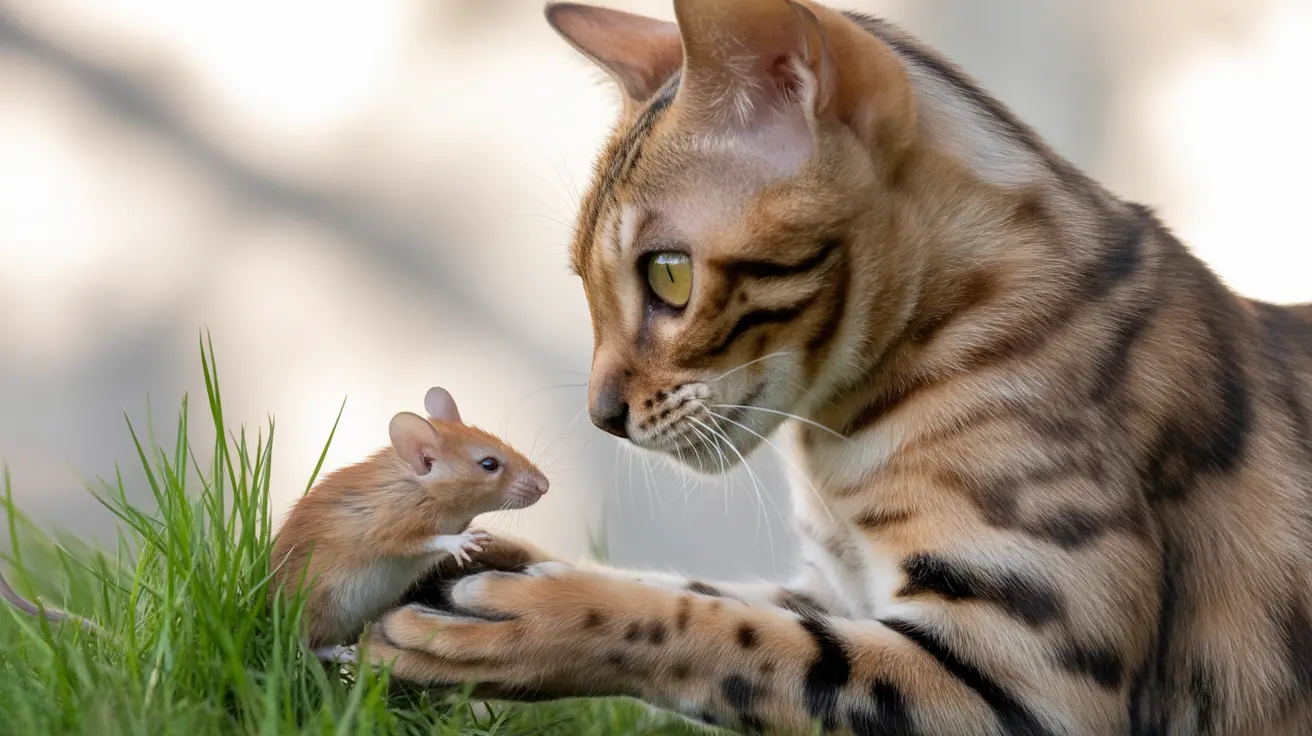Bornavirus Risk for Cat Owners: Understanding the Fatal Brain Infection Threat from Field Mice
The Bornavirus, specifically BoDV-1 (Borna disease virus-1), represents one of the most serious yet under-recognized zoonotic threats facing cat owners today. This neurotropic virus, which causes fatal encephalitis in humans, has emerged as a significant public health concern, particularly in Central European regions where field mice serve as natural reservoirs. While cats themselves are not the primary source of infection, they play a crucial role as intermediary hosts that can expose their owners to this deadly pathogen through contact with contaminated prey.
Understanding the Bornavirus risk for cat owners is essential, as confirmed human infections, though rare, demonstrate alarmingly high case fatality rates with no available vaccine or specific treatment. The virus's ability to cause severe brain inflammation, combined with its geographic concentration in areas where many cat owners reside, makes this knowledge potentially life-saving. This comprehensive guide will explore how the virus spreads, why cat owners face elevated risks, and most importantly, what preventive measures can protect both feline companions and their human families.
Understanding Bornavirus: The Silent Neurological Threat
Borna disease virus (BDV) is a negative-sense, single-stranded RNA virus with a compact genome of approximately 9 kilobases. First identified in the late 19th century near Borna, Germany, this unique pathogen stands apart from other RNA viruses due to its unusual replication strategy—it replicates and transcribes its genome within the host cell's nucleus, a characteristic typically associated with DNA viruses.
The virus demonstrates remarkable genetic stability among field isolates, with specific phylogenetic clusters correlating directly with geographic regions. This stability reflects the limited mobility of its primary reservoir hosts and explains why spill-over infections into domestic animals and humans remain geographically concentrated. The virus encodes several critical proteins including nucleoprotein, phosphoprotein, matrix protein, glycoprotein, and polymerase, all working together to facilitate persistent neural infection.
The Field Mouse Connection: Primary Reservoir and Transmission
The natural reservoir of BDV is the bicolored white-toothed shrew (Crocidura leucodon), which harbors the virus in multiple tissues and sheds infectious particles through saliva, urine, feces, and skin scales. This continuous shedding facilitates widespread environmental contamination in areas where these shrews are present, creating multiple exposure pathways for both cats and humans.
Field mice and other small rodents can become infected through contact with contaminated environments, making them secondary reservoirs and carriers. When cats hunt these infected rodents, they become exposed to high concentrations of the virus present in the prey's tissues and bodily fluids. The virus persists primarily in neural cells, including neurons, astrocytes, and oligodendrocytes, meaning that infected rodent brain tissue represents a particularly concentrated source of viral particles.
Why Cats Are "Dead-End" Hosts in the Bornavirus Lifecycle
Cats function as what epidemiologists term "dead-end" or incidental hosts in the Bornavirus transmission cycle. This classification means that while cats can become infected with the virus, they do not efficiently transmit it to other cats or back to the primary reservoir species. The virus demonstrates a broad host range, infecting various mammals including cats, but the infection pathway in felines typically represents a terminal point rather than a continuation of the transmission cycle.
When cats become infected, the virus can establish persistent infection in neural tissue, particularly in neurons and glial cells. However, cats are tightly cell-associated with the virus, meaning limited release occurs into bodily fluids compared to the primary reservoir species. This characteristic significantly reduces, though does not eliminate, the risk of direct cat-to-human transmission through typical pet contact like petting or grooming.
The real danger for cat owners emerges not from direct contact with their infected pets, but from handling virus-contaminated materials that cats bring into the home environment. This includes infected prey animals, contaminated litter box materials where infected rodent remains might be deposited, or environmental surfaces where cats have left traces of infected rodent tissue or bodily fluids.
Geographic Risk Areas: Where Cat Owners Face Greatest Danger
Confirmed human infections with BoDV-1 show distinct geographic clustering in Central Europe, corresponding directly to endemic regions where the virus circulates in animal populations. The highest risk areas include specific regions of Germany (particularly Bavaria and Saxony-Anhalt), Switzerland, Austria, and Liechtenstein. This geographic concentration reflects the distribution of the primary reservoir species and the ecological conditions that support sustained viral circulation.
Cat owners in these regions face elevated risk due to the increased likelihood that local rodent populations carry the virus. The molecular epidemiology of BDV supports limited virus spread patterns consistent with the low mobility of reservoir hosts, meaning that risk remains concentrated in specific geographic pockets rather than being widely distributed. However, this concentration also means that many infections likely go undiagnosed, as healthcare providers in these areas may not immediately consider Bornavirus when evaluating patients with neurological symptoms.
Recognizing Neurological Symptoms in Cats and Humans
Bornavirus infection manifests primarily as nonpurulent meningoencephalomyelitis with a particular predilection for the gray matter of cerebral hemispheres and brain stem. In cats, neurological symptoms can include ataxia, seizures, behavioral abnormalities such as increased anxiety or aggression, cognitive deficits, and in severe cases, paralysis. The disease progression is immunopathogenic, meaning that clinical signs result largely from T-cell-mediated immune responses rather than direct viral damage to neural tissue.
In humans, BoDV-1 infection causes severe encephalitis with symptoms appearing relatively late in the disease progression. The immune-mediated mononuclear cell infiltration, primarily involving CD8+ and CD4+ T cells, natural killer cells, macrophages, and activated microglia, leads to progressive neurological deterioration. Early symptoms might include headache, fever, and altered mental status, progressing rapidly to more severe neurological manifestations.
The challenge for both veterinarians and physicians lies in the nonspecific nature of early symptoms and the rarity of confirmed cases. Many neurological conditions can present similarly, making differential diagnosis crucial. Pet owners should be particularly alert to sudden behavioral changes in cats, especially if the animals have recent history of hunting or contact with rodents, and should seek immediate veterinary evaluation for any concerning neurological symptoms.
Transmission Pathways: How Cat Owners Become Exposed
The primary transmission pathway for cat owners involves contact with virus-contaminated materials rather than direct transmission from cats themselves. When cats hunt infected field mice or shrews, they can carry contaminated prey back to the home environment. The virus remains viable in infected tissue and can contaminate surfaces, litter boxes, and areas where cats deposit or consume their prey.
Cat owners face exposure risk when handling dead rodents that cats bring home, cleaning litter boxes that may contain contaminated materials, or touching surfaces where infected prey has been present. The virus can be transmitted through mucous membranes or broken skin, making proper protective measures essential during any cleanup activities. Additionally, cats that spend time outdoors may track viral particles on their fur or paws, though this represents a lower-risk exposure pathway.
Environmental contamination represents another significant concern. The bicolored white-toothed shrew sheds infectious particles through multiple bodily secretions, creating widespread environmental contamination in endemic areas. Cats that explore contaminated environments can subsequently bring viral particles into homes on their fur, bedding, or toys.
Preventive Measures for High-Risk Cat Owners
Given the absence of vaccines or specific treatments for Bornavirus infection, prevention remains the most critical strategy for protecting cat owners. Primary preventive measures focus on reducing exposure to potentially contaminated materials and implementing proper hygiene protocols when exposure cannot be avoided.
Essential protective measures include always wearing disposable gloves when handling any dead rodents that cats bring home, using proper disposal methods for contaminated materials, and maintaining strict hand hygiene after any contact with cats that spend time outdoors. When cleaning litter boxes, cat owners should wear gloves and consider using masks if there's any possibility of contaminated rodent remains being present.
For cat owners in high-risk geographic areas, additional precautions may be warranted. These include limiting cats' outdoor access during peak rodent activity periods, regularly disinfecting areas where cats spend time, and being particularly vigilant about protective equipment when handling any materials that cats bring from outside environments. UV radiation, heat, pH changes, detergents, and organic solvents can inactivate the virus, making thorough cleaning with appropriate disinfectants an effective preventive strategy.
Managing Outdoor Cats in Endemic Areas
Cat owners in Bornavirus-endemic regions face particular challenges in managing outdoor cats safely. Complete indoor restriction may not be practical or desirable, but strategic management can significantly reduce transmission risks. Implementing supervised outdoor time, creating enclosed outdoor spaces that limit hunting opportunities, and regular veterinary monitoring can help balance cats' natural behaviors with disease prevention.
Regular veterinary check-ups become particularly important for outdoor cats in endemic areas. While specific Bornavirus testing may not be routinely available, veterinarians can monitor for neurological symptoms and provide guidance on risk reduction strategies. Cat owners should maintain detailed records of their cats' outdoor activities, hunting behaviors, and any changes in neurological function to assist veterinary assessment.
Environmental modifications around homes can also help reduce risk. Removing attractions for rodents such as accessible food sources, maintaining clean outdoor areas, and using physical barriers to limit rodent access to areas where cats spend time can decrease the likelihood of cats encountering infected prey animals.
Diagnostic Challenges and Current Limitations
Diagnosing BDV infection in both humans and animals presents significant challenges due to the lack of standardized, validated diagnostic assays with adequate sensitivity and specificity. Current diagnostic approaches rely on serological assays including immunofluorescence, immunoblot, and ELISA, along with molecular detection of viral RNA by RT-PCR, immunohistochemistry for viral antigen detection, and viral isolation through cell culture or animal bioassay.
Technical challenges include variability in test performance and the need for specialized laboratory capabilities that may not be widely available. RT-PCR methods require careful controls to prevent false positives from contamination and demonstrate variable sensitivity depending on sample type and viral load. For cat owners seeking testing for their pets or themselves, working with veterinarians and physicians familiar with zoonotic diseases becomes essential.
The rarity of confirmed human cases also means that many healthcare providers may have limited familiarity with Bornavirus infection, potentially leading to delayed diagnosis or misattribution of symptoms to more common conditions. Cat owners in endemic areas should ensure their healthcare providers are aware of their potential exposure risks through pet contact with rodents.
What to Do If Exposure Occurs
Cat owners who suspect they may have been exposed to Bornavirus should seek immediate medical attention, particularly if they develop any neurological symptoms following potential exposure events. While no specific treatment exists, early medical intervention can provide supportive care and help manage complications as they arise.
Documentation of exposure events becomes crucial for proper medical evaluation. Cat owners should record details about contact with potentially infected animals, timing of exposure, protective measures used or not used, and any subsequent symptoms. This information can help healthcare providers assess risk levels and determine appropriate monitoring or intervention strategies.
For cats showing neurological symptoms, immediate veterinary evaluation is essential. While treatment options remain limited, veterinary care can provide supportive therapy and help manage symptoms. Additionally, confirming infection status in cats can provide important information about household exposure risks and guide additional protective measures for family members.
Comparing Bornavirus Risks to Other Pet-Related Zoonoses
When evaluated against other zoonotic diseases that cats can transmit, Bornavirus presents a unique risk profile characterized by high severity but low transmission probability. Unlike more common pet-related zoonoses such as cat scratch disease or toxoplasmosis, Bornavirus infections are rare but demonstrate extremely high case fatality rates when they do occur.
This risk profile requires a different approach to prevention compared to other pet-related health concerns. While routine pet care and basic hygiene measures provide adequate protection against most common zoonoses, Bornavirus prevention requires more specific protective measures focused on avoiding contact with potentially contaminated rodent materials.
The geographic restriction of Bornavirus risk also differs from more widely distributed pet-related diseases. Cat owners outside of endemic Central European regions face minimal risk, while those within affected areas must maintain heightened awareness and preventive measures. This geographic specificity makes targeted education and prevention strategies particularly important for at-risk populations.
Frequently Asked Questions
Can cats directly transmit Bornavirus to humans through normal pet contact?
Direct transmission from cats to humans through normal petting, grooming, or cuddling is extremely unlikely. Cats are "dead-end" hosts with tightly cell-associated infections that produce limited viral shedding into bodily fluids. The primary risk comes from handling contaminated prey animals or materials that infected cats bring into the home environment.
How can I tell if my cat has been exposed to Bornavirus?
Neurological symptoms in cats may include ataxia, seizures, behavioral changes like increased anxiety or aggression, cognitive deficits, and in severe cases, paralysis. However, these symptoms are nonspecific and can result from many other conditions. Cats with recent hunting activity in endemic areas showing any neurological symptoms should receive immediate veterinary evaluation.
Are indoor cats safe from Bornavirus infection?
Indoor cats have significantly lower risk but are not completely immune if they have any access to potentially contaminated materials. Cats that occasionally go outside, have access to outdoor areas like patios or gardens, or live in homes where rodents might enter can still face some exposure risk, though much lower than outdoor hunting cats.
What should I do if my cat brings home a dead mouse?
Always wear disposable gloves when handling dead rodents, use tools like tongs or shovels rather than direct contact, dispose of the carcass in sealed bags, disinfect any contaminated surfaces with appropriate cleaners, and wash hands thoroughly with soap and hot water after cleanup, even when wearing gloves.
Is there a vaccine available for Bornavirus?
No licensed vaccines are currently available for either cats or humans. Experimental studies have tested inactivated and attenuated virus vaccines in animal models, but these provide only incomplete protection and are not available for clinical use. Prevention through avoiding exposure remains the only reliable protection method.
How long does the virus survive in the environment?
Bornaviruses are relatively fragile and can be inactivated by heat, UV radiation, pH changes, detergents, and organic solvents. However, the virus can persist in infected tissue and bodily secretions for extended periods under favorable conditions. Thorough cleaning and disinfection of potentially contaminated areas is essential for elimination.
Should I restrict my cat's outdoor access if I live in an endemic area?
While complete indoor restriction offers the highest protection, this decision should balance your cat's wellbeing with risk levels. Consider supervised outdoor time, enclosed outdoor spaces that limit hunting, and regular veterinary monitoring as compromise strategies. Discuss your specific situation with a veterinarian familiar with local risk conditions.
Conclusion
The Bornavirus risk for cat owners represents a serious but manageable health concern that requires informed awareness and appropriate preventive measures. While human infections remain rare, the extremely high case fatality rates and absence of effective treatments make prevention absolutely critical for cat owners in endemic Central European regions. Understanding that cats serve as intermediary rather than primary sources of infection helps focus protective efforts on the most dangerous exposure pathways—handling contaminated prey and cleanup materials rather than normal pet interactions.
The key to protection lies in implementing consistent safety practices when dealing with any materials that outdoor cats might contaminate, maintaining excellent hygiene protocols, and seeking prompt medical or veterinary attention when concerning symptoms arise. Cat owners in affected geographic areas should work closely with healthcare providers and veterinarians who understand zoonotic disease risks to develop appropriate monitoring and prevention strategies. Through informed awareness and proper precautions, cat owners can continue enjoying their feline companions while minimizing their exposure to this serious neurological threat.






